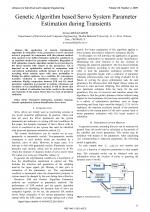| 2/2010 - 13 |
Genetic Algorithm based Servo System Parameter Estimation during TransientsREZAZADEH, A. |
| Extra paper information in |
| Click to see author's profile in |
| Download PDF |
Author keywords
parameter estimation, transient response, genetic optimization, system identification, servo drive
References keywords
rezazade(4), optimization(4), genetic(4)
Blue keywords are present in both the references section and the paper title.
About this article
Date of Publication: 2010-05-31
Volume 10, Issue 2, Year 2010, On page(s): 77 - 81
ISSN: 1582-7445, e-ISSN: 1844-7600
Digital Object Identifier: 10.4316/AECE.2010.02013
Web of Science Accession Number: 000280312600013
SCOPUS ID: 77954628271
Abstract
The application of Genetic Optimization Algorithm in estimation of the parameters of servo electrical drives is proposed. In comparison with this planned method, least squared error (LSE) estimation method is considered as an expedient method for parameter estimation. Regardless of LSE estimation, Genetic Algorithm method is not restricted to the linear systems with respect to the parameters. GA is imported as an optimization method in comparison with conventional optimization methods because of its power in searching whole solution space with more probability to finding the global optimum. As a condition for convergence, transient excitation is considered instead of persistent excitation. Finally, comparison between LSE and GA based parameter estimation is presented to indicate robustness and resolution of GA identification method. It will be shown that the GA method of estimation has better results in the startup and transients of the system where there is a lack of persistent excitation. |
| References | | | Cited By |
Web of Science® Times Cited: 5 [View]
View record in Web of Science® [View]
View Related Records® [View]
Updated today
SCOPUS® Times Cited: 8
View record in SCOPUS® [Free preview]
View citations in SCOPUS® [Free preview]
[1] Recent Trends of Control Strategies for Doubly Fed Induction Generator Based Wind Turbine Systems: A Comparative Review, Karad, Shivaji, Thakur, Ritula, Archives of Computational Methods in Engineering, ISSN 1134-3060, Issue 1, Volume 28, 2021.
Digital Object Identifier: 10.1007/s11831-019-09367-3 [CrossRef]
[2] Wind Generators Test Bench. Optimal Design of PI Controller, TUDORACHE, T., BOSTAN, V., Advances in Electrical and Computer Engineering, ISSN 1582-7445, Issue 3, Volume 11, 2011.
Digital Object Identifier: 10.4316/aece.2011.03011 [CrossRef] [Full text]
[3] FPGA-Based Embedded System Architecture for Micro-Genetic Algorithms Applied to Parameters Optimization in Motion Control, JAEN-CUELLAR, A. Y., MORALES-VELAZQUEZ, L., ROMERO-TRONCOSO, R., OSORNIO-RIOS, R. A., Advances in Electrical and Computer Engineering, ISSN 1582-7445, Issue 1, Volume 15, 2015.
Digital Object Identifier: 10.4316/AECE.2015.01004 [CrossRef] [Full text]
Disclaimer: All information displayed above was retrieved by using remote connections to respective databases. For the best user experience, we update all data by using background processes, and use caches in order to reduce the load on the servers we retrieve the information from. As we have no control on the availability of the database servers and sometimes the Internet connectivity may be affected, we do not guarantee the information is correct or complete. For the most accurate data, please always consult the database sites directly. Some external links require authentication or an institutional subscription.
Web of Science® is a registered trademark of Clarivate Analytics, Scopus® is a registered trademark of Elsevier B.V., other product names, company names, brand names, trademarks and logos are the property of their respective owners.
Faculty of Electrical Engineering and Computer Science
Stefan cel Mare University of Suceava, Romania
All rights reserved: Advances in Electrical and Computer Engineering is a registered trademark of the Stefan cel Mare University of Suceava. No part of this publication may be reproduced, stored in a retrieval system, photocopied, recorded or archived, without the written permission from the Editor. When authors submit their papers for publication, they agree that the copyright for their article be transferred to the Faculty of Electrical Engineering and Computer Science, Stefan cel Mare University of Suceava, Romania, if and only if the articles are accepted for publication. The copyright covers the exclusive rights to reproduce and distribute the article, including reprints and translations.
Permission for other use: The copyright owner's consent does not extend to copying for general distribution, for promotion, for creating new works, or for resale. Specific written permission must be obtained from the Editor for such copying. Direct linking to files hosted on this website is strictly prohibited.
Disclaimer: Whilst every effort is made by the publishers and editorial board to see that no inaccurate or misleading data, opinions or statements appear in this journal, they wish to make it clear that all information and opinions formulated in the articles, as well as linguistic accuracy, are the sole responsibility of the author.



